Related Research Articles

Oaxaca, officially the Free and Sovereign State of Oaxaca, is one of the 32 states that compose the Federative Entities of Mexico. It is divided into 570 municipalities, of which 418 are governed by the system of usos y costumbres with recognized local forms of self-governance. Its capital city is Oaxaca de Juárez.
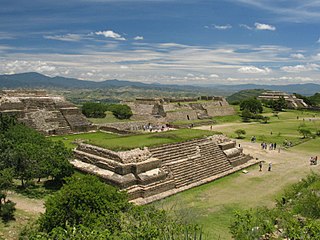
Oaxaca de Juárez, or simply Oaxaca, is the capital and largest city of the eponymous Mexican state of Oaxaca. It is the municipal seat for the surrounding municipality of Oaxaca. It is in the Centro District in the Central Valleys region of the state, in the foothills of the Sierra Madre at the base of the Cerro del Fortín, extending to the banks of the Atoyac River.
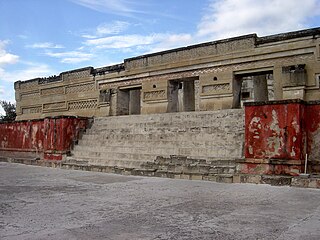
Mitla is the second-most important archeological site in the state of Oaxaca in Mexico, and the most important of the Zapotec culture. The site is located 44 km from the city of Oaxaca, in the upper end of the Tlacolula Valley, one of the three cold, high valleys that form the Central Valleys Region of the state. At an elevation of 4,855 ft, surrounded by the mountains of the Sierra Madre del Sur, the archeological site is within the modern municipality of San Pablo Villa de Mitla. It is 24 mi (38 km) southeast of Oaxaca city. While Monte Albán was the most important politically of the Zapotec centers, Mitla became the main religious one in a later period as the area became dominated by the Mixtec.

Tehuantepec is a city and municipality in the southeast of the Mexican state of Oaxaca. It is part of the Tehuantepec District in the west of the Istmo Region. The area was important in pre-Hispanic period as part of a trade route that connected Central America with what is now the center of Mexico. Later it became a secondary capital of the Zapotec dominion, before it was conquered by the Spanish in the early 16th century.

Arturo García Bustos was a Mexican painter and print maker. He is known as one of “Los Fridos” students who studied under Frida Kahlo at her home in Coyoacán.

Juchitán de Zaragoza is an indigenous town in the southeast of the Mexican state of Oaxaca. It is part of the Juchitán District in the west of the Istmo de Tehuantepec region. With a 2020 census population of 88,280, it is the third-largest city in the state. The majority of the indigenous inhabitants are Zapotecs and Huaves. The town also serves as the municipal seat for the surrounding municipality, with which it shares a name. The municipality has an area of 414.64 km2 and a population of 113,570, the state's third-largest in population.

The Zapotec languages are a group of around 50 closely related indigenous Mesoamerican languages that constitute a main branch of the Oto-Manguean language family and are spoken by the Zapotec people from the southwestern-central highlands of Mexico. A 2020 census reports nearly half a million speakers, with the majority inhabiting the state of Oaxaca. Zapotec-speaking communities are also found in the neighboring states of Puebla, Veracruz, and Guerrero. Labor migration has also brought a number of native Zapotec speakers to the United States, particularly in California and New Jersey. Most Zapotec-speaking communities are highly bilingual in Spanish.

Natalia Toledo Paz is a Mexican poet who writes in Spanish and Zapotec. Her work helped to revive interest in the Zapotec language. Ida Kozlowska-Day states that Toledo is "one of the most recognized contemporary poets in the native languages of Mexico."
Demián Flores Cortés is a contemporary Mexican artist who works in multiple media. He has worked in graphic arts, painting, serigraphy and more producing work which often mixes images from his rural childhood home of Juchitán with those related to modern Mexico City. It also often including the mixture of pop culture images with those iconic of Mexico’s past. Much of Flores’ work has been associated with two artists’ workshops he founded in Oaxaca called La Curtiduría and the Taller Gráfica Actual. This work has included events related to the 2006 uprising in Oaxaca and the restoration of an 18th-century church. His work has been exhibited in Mexico City, Europe, Guatemala and Cuba.

The Indigenous people of Oaxaca are descendants of the inhabitants of what is now the state of Oaxaca, Mexico, who were present before the Spanish invasion. Several cultures flourished in the ancient region of Oaxaca from as far back as 2000 BC, of whom the Zapotecs and Mixtecs were perhaps the most advanced, with complex social organization and sophisticated arts.

Luis Pérez Figueroa was a Mexican general who fought in the war of independence that followed the French intervention in Mexico.
IGNACIO ORTIZ CEDEÑO

Mauricio García Vega is a Mexican painter whose work has been recognized by various awards and membership in the Salón de la Plástica Mexicana. His work is mostly focused on urban landscapes, often with dark themes and a chaotic feel. He works both alone and with his brother Antonio García Vega. He lives and works in the Mexico City suburb of Ciudad Nezahualcóyotl.
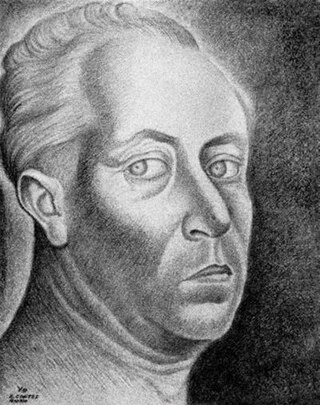
Erasto Cortés Juárez was a Mexican artist and a founding member of the Salón de la Plástica Mexicana.
Eliana Menassé is a Mexican painter and member of the Salón de la Plástica Mexicana, an honor society for Mexican artists.
Roberto Donis was a Mexican painter and art teacher. He began studying art at the Escuela Nacional de Pintura, Escultura y Grabado "La Esmeralda", but unsatisfied with the instruction, helped organize a student strike. It was unsuccessful and rather than return to school, he decided to go to Morelia to teach. Donis’ art career consisted of exhibitions both in Mexico and abroad, including an important exhibition at the Museo de Arte Moderno in Mexico City and accepted as a regular with the prestigious Galería de Arte Mexicano. His teaching career included directorship at the Universidad Autónoma Benito Juárez as well as helping to found the Taller de Artes Plásticas Rufino Tamayo in the city of Oaxaca. He received several recognitions for his work, including membership in the Salón de la Plástica Mexicana.

Heriberto Juárez was a self-taught Mexican sculptor, known for his depictions of women and animals, especially bulls. As a youth he wanted to be a bullfighter but gave this up when he found he could sell figures he made. While never formally trained, he had over seventy individual exhibitions of his work in Mexico and the United States and his work can be found in prominent public and private collections.

Julia López is a Mexican painter whose works depict her childhood home in the Costa Chica region of Guerrero state. She was born in a small farming village but left early for Acapulco and Mexico City to find a better life. In the capital, she was hired as a model for artists at the Escuela Nacional de Pintura, Escultura y Grabado "La Esmeralda" and as such became part of the circle of notable artists of that time. Their influenced encouraged her to draw and paint, with Carlos Orozco Romero discouraging her from formal instruction as to not destroy her style. She began exhibiting in 1958 and since then has exhibited individually and collectively in Mexico, the United States and Europe. Her work has been recognized with awards and membership in the Salón de la Plástica Mexicana.
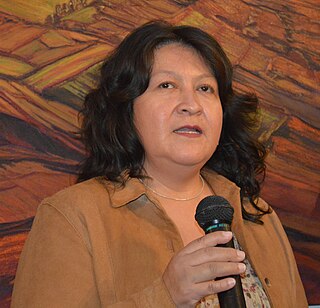
Angelica Carrasco is a Mexican graphic artist who is a pioneer of large scale printmaking in the country. Her work often is related to violence and classified as “abstract neo-expressionism.” Much of her career has been dedicated to teaching and the promotion of the arts, especially the graphic arts and has been recognized with membership in the Salón de la Plástica Mexicana and the Sistema Nacional de Creadores de Arte.
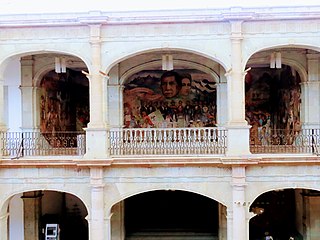
Oaxaca en la historia y en el mito is a huge mural created by Arturo García Bustos (1926-2017). García Bustos was "an artist dedicated to the humanistic struggles and liberal ideals that he expressed profoundly in his art." He painted the mural in a stairwell in the Palacio de Gobierno in Oaxaca. When this was written the location was officially known as the Museo del Palacio Universum, but it was commonly referred to as the Palacio de Gobierno. It is located in Oaxaca de Juárez, México, known in English as Oaxaca City.
References
- 1 2 3 4 "Azteca de Gyvés de la Cruz". Sistema de Información Cultural (in Spanish). Mexico: CONACULTA. Retrieved September 27, 2012.
- 1 2 Blanca Ruiz (August 10, 1995). "Juchitan es en ella un tejido de seda" [Juchitan is a silk cloth for them]. Reforma (in Spanish). Mexico City. p. 11.
- 1 2 "Azteca de Gyves presenta la exposición "Huevos al gusto" en Puebla" (in Spanish). Mexico: State of Oaxaca. June 8, 2012. Archived from the original on December 20, 2012. Retrieved September 27, 2012.
- 1 2 3 Azteca de Gyves. "La geometría y la Greca" (in Spanish). Mexico City: Museo de las Mujeres. Archived from the original on January 29, 2013. Retrieved September 27, 2012.
- ↑ Paula Carrizosa (June 13, 2012). "Las grecas mesoamericanas, el tema central del trabajo plástico de Azteca de Gyves" [Mesoamerican fretwork, the central theme of work by Azteca de Gyves]. La Jornada de Oriente (in Spanish). Puebla. Retrieved September 27, 2012.
- ↑ "Les dan 'MAZ' grabados" [They give prints to MAZ]. Mural (in Spanish). Guadalajara. February 25, 2007. p. 14.
- ↑ "Juárez en la visión de 17 oaxaqueños" [Juarez in the view of seventeen Oaxacans]. El Universal (in Spanish). Mexico City. March 25, 2007. p. 14.
- ↑ Corina Preciado (August 27, 2002). "Muito Obrigado muchas gracias" [Muito Obrigado Thank you very much]. Mural (in Spanish). Guadalajara. p. 4.